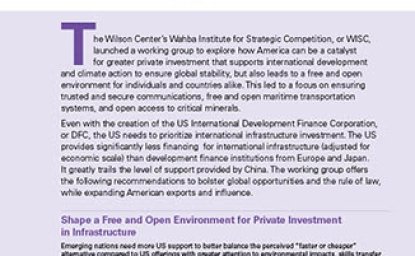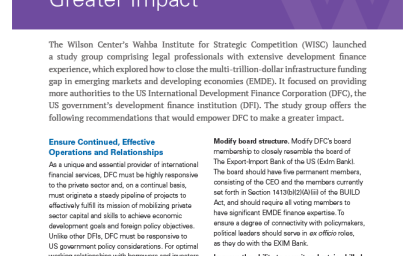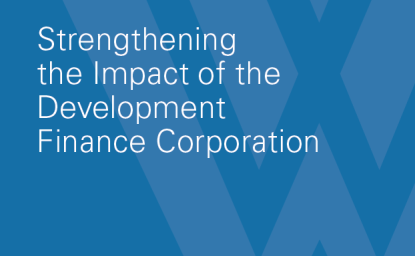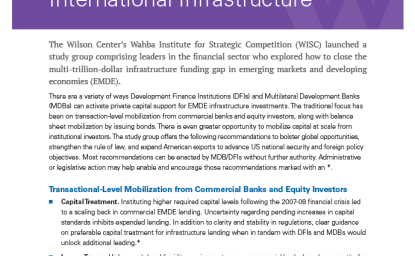The gap between funding requirements (much of which is in developing countries) and funding availability by 2040 is estimated to be $15 trillion. To close it, governments must look beyond public budgets. Mobilizing private-sector capital to invest in developing countries’ infrastructure will require government-supported development finance institutions (DFIs), such as the US International Development Finance Corporation (DFC), to provide credit enhancements, including subordinated debt, to mitigate some of the associated political and commercial risks that limit participation of private-sector capital in infrastructure development. But what is subordinated debt and how can it help fill the funding gap?
Subordinated debt defined
Subordinated debt is any debt that is junior to other debt. Subordinated debt sits in the “capital stack” (see diagram below) between equity, the highest-risk investment, and senior debt, the least risky. A borrower’s earnings and assets will be used first to settle the claims of the senior debt providers. Only after senior claims are settled will any residual borrower earnings and assets be applied to claims of the subordinated debt providers. Equity falls last in the order of priority.
Examples of subordinated debt include unsecured loans, mezzanine loans, convertible loans, and working capital credit lines. As compensation for the additional risk, the subordinated lender will receive a greater return, which can take different forms, including a higher interest rate or additional fees or an option to participate in equity returns through warrants or similar instruments.

A home equity loan is a simple example of subordinated debt. Home equity loans or lines of credit are subordinated to any first mortgage loan taken out to buy the home. If you default on your mortgage loan, the value of the home is applied first to pay the balance on the mortgage loan. Any amount remaining after repayment of the mortgage loan is then applied against the balance on a home equity line. The wide availability of such loans attests that many lenders profitably provide subordinated debt.
How it can mobilize greater private investment in developing markets
DFIs alone cannot close the infrastructure funding gap. Private sector capital of all sorts must be mobilized, including not only commercial bank lenders, but also institutional investors. The risk appetite of private capital providers, particularly for projects in emerging markets and developing economies, is limited by factors that include a lack of market familiarity, shareholder limitations, and regulatory restrictions. Without appropriate risk mitigation and credit enhancement, private sector capital will not be activated, and critical infrastructure will not be developed. When a DFI such as the DFC provides its support in the form of subordinated debt rather than as senior secured debt, it makes space in a lower risk spot in the capital stack (see graph) for private sector capital. Subordinated debt leverages the DFC’s available resources. The DFC can reduce the total dollars committed to a particular project when it creates a senior position for private capital.
Why can’t all lenders–private sector and the DFC–simply sit at the top of the capital stack as senior lenders? The simple reason is because infrastructure development by its nature is capital intensive, not asset intensive. In capital-intensive projects, the value of project assets (particularly during construction) is almost certainly inadequate to provide enough collateral value to support all of the debt at a senior secured level. By moving into a subordinated position, the DFC can make some of that collateral value available to less risk tolerant private sector lenders. As a DFI, the DFC is in a better position to evaluate and price the project risk through a higher interest rate on subordinated debt.
Under the BUILD Act, the DFC’s purpose is “to mobilize and facilitate the participation of private sector capital and skills in the economic development of less developed countries.” The DFC now deploys its support as a principal project investor primarily by providing senior secured debt. To make meaningful progress against investment targets, the DFC must expand beyond its traditional activities and look for ways to mobilize more private capital to invest alongside it. One way for the DFC to achieve that would be to move out of the senior secured position and make room for private capital on appropriate projects.
The Wahba Institute for Strategic Competition recommends providing the DFC greater leeway in structuring loans to include, without seeking special approvals, subordinated debt as a tool to activate more private-sector capital into infrastructure development. Read these and other recommendations by our working groups here.
Authors


Associate Professor in the School of Government and Public Policy and the James E. Rogers College of Law, University of Arizona

Wahba Institute for Strategic Competition
The Wahba Institute for Strategic Competition works to shape conversations and inspire meaningful action to strengthen technology, trade, infrastructure, and energy as part of American economic and global leadership that benefits the nation and the world. Read more

Explore More
Browse Insights & Analysis
Investing in Infrastructure Bolsters a More Stable, Free and Open World

Empowering Development Finance Corporation for Greater Impact




